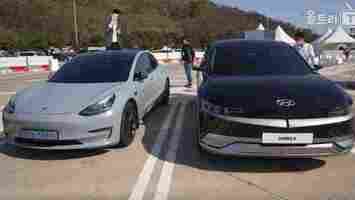UK government implies current EV grant will be culled
In March, the UK government cut its electric vehicle grant for the fourth time in ten years. Specifically, it reduced the subsidy by $700 (£500) to $3,480 (£2,500), and capped price eligibility at $49,000 (£35,000) from $68,000 (£50,000).

On Monday, during an interview with Autocar , Transport Decarbonization Minister Rachel Maclean defended the government’s decision and hinted that the “Plug-in Grant” might be disposed of altogether.
She explained that the reduced EV grant is now targeting “lower-priced vehicles” because “that’s where people are less likely to be able to fund the cost out of their own pocket entirely.”
Well, that’s not really unfair, given that the cut is mainly going to affect people who already have quite a bit of money to spend on a car. And there are still 27 eligible electric models , such as the more affordable Renault Zoe, and even the BMW i3 series.
Regarding the grant’s potential slash, Maclean told Autocar that “ it’s right to keep on looking at that [the future of the scheme], because ultimately we need to make sure we’re not using government money to help people buy cars who could have afforded them anyway.”
“ One of our concerns is to make this an equitable transition for everyone, and of course at the moment electric cars are a bit more expensive — although if you factor in the overall cost of ownership, they will be on a parity soon.”
Interestingly, the intention to recall the grant had been already announced in the government’s Road to Zero plan, back in 2018.
In the interview, Maclean also suggested that hydrogen and synthetic e-fuels will also play a role in decarbonizing transport, but this will not include passenger cars.
Instead, the focus will be on heavy goods vehicles (HGVs), airplanes, and ships.
As a matter of fact, these statements seem to correspond with the government’s “ greenprint ” to decarbonize all modes of domestic transport by 2050, published just a week ago.
As EVs become the norm, we shouldn’t be too surprised by the potential removal of subsidies. After all, such incentives were designed to encourage people to make the switch from combustion to electricity by trying to balance the price disparity between the two types of vehicles.
This means that we can eventually expect governments around the world to lift their EV grants and to even impose other related taxes, as fuel duty will gradually disappear and they’ll have to fill the financial gap.
But seeing that EVs aren’t the norm yet, a nd it’ll be some more years before they’re dominant , withdrawing financial incentives too soon may hinder the sought-after transition.
Do EVs excite your electrons? Do ebikes get your wheels spinning? Do self-driving cars get you all charged up?
Then you need the weekly SHIFT newsletter in your life. Click here to sign up .
Virgin Hyperloop co-founder says commercial trips could start in 2027
Magnetic floating pods traveling through a series of tubes sound like a scene from sci-fi movies, right? But what if they could be used for mass transport?

The American transport tech company Virgin Hyperloop expects to make it happen by 2027, co-founder and Chief Executive Josh Giegel told Reuters .
The company is developing tech for passenger pods that will reach a speed up to 1,200 kilometers through almost air-free vacuum tunnels using magnetic levitation.
Simply put, the pods are super-fast because the lack of air and the magnetic levitation reduce friction.
They will accommodate 28 passengers, and will also be used for freight.
“It will feel like an aircraft at take-off and once you’re at speed,” Geigel said. Well, that’s exciting.
Virgin Hyperloop is not alone in the race to revolutionize travel, especially since Elon Musk reignited interest in the system back in 2013.
Nevertheless, last November it run the first successful safety test with human passengers.
Virgin Hyperloop will make its first routes in India and Saudi Arabia, where the transport systems are overloaded or underdeveloped.
To offer a glimpse in the future, a hyperloop promises to reduce the three-and-a-half-hour trip from Mumbai to Pune to just 35 minutes.
Do EVs excite your electrons? Do ebikes get your wheels spinning? Do self-driving cars get you all charged up?
Then you need the weekly SHIFT newsletter in your life. Click here to sign up .
Hyundai’s Ioniq 5 EV is a deceptively chonky boy
It’s virtually impossible to get a true understanding of a new car’s dimensions and stance until we see it alongside models we already know.

A few weeks ago , Hyundai’s electric spinoff brand Ioniq unveiled its first model, simply called the 5. Everyone seemed to agree that it is a good looking car, but something didn’t add up.
Ioniq insists the 5 is a crossover, but in the pictures it looked a lot more like a hatchback. Crossovers are supposed to be big, and chunky, but in the company’s press images it just didn’t look to be.


However, thanks to a Korean YouTube channel that somehow managed to get an Ioniq 5 alongside a Tesla Model 3, we have a much clearer understanding of just how big the 5 actually is.
Turns out it’s a chunky one. Check it out in the video below.
While the Model 3 isn’t exactly a big car, it’s not a small one either. It’s a decidedly average sized car with a wheelbase of 287.5 cm and a roofline of 144 cm.
Alongside the Ioniq 5, it’s dwarfed in every direction. The Ioniq 5’s wheelbase is longer (by over 10 cm), it’s taller (by about 20 cm), it’s wider (by about 5 cm), and as a result, it’s more spacious inside.
The video also shows off a host of other cool features on the Ioniq 5, such as its ability to drive itself out of car parking spaces. The video also appears to show the Ioniq 5 charge the Tesla Model 3 using its V2L feature — although it does so very slowly.
The EV motoring community is quite excited about the arrival of the Ioniq 5, and understandably so. It’s slated to have 300 miles of range, tonnes of space, and will likely be very affordable.
All we have to do is wait for it to arrive here!
HT – Carscoops
Do EVs excite your electrons? Do ebikes get your wheels spinning? Do self-driving cars get you all charged up?
Then you need the weekly SHIFT newsletter in your life. Click here to sign up .